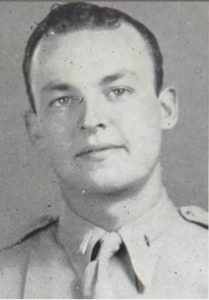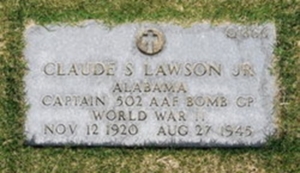Scroll of Honor – Claude Sims Lawson, Jr
After the Fighting Stopped
Written by: Kelly Durham
Hostilities in the Pacific theater had been suspended pending the formal surrender of the Japanese. That ceremony was still a week away, but Captain Claude Sims Lawson, Jr. and his B-29 crew continued to fly missions—only now their focus was on dropping supplies, not bombs.
Lawson, an engineering major from Birmingham, Alabama, was a member of Clemson’s Class of 1944. After the Japanese attacked Pearl Harbor, Lawson left Clemson and joined the Army Air Force. He applied for flight training and was accepted. As he progressed through basic, primary, and advanced flight schools, he was channeled into multi-engine bombers.
Lawson was assigned as a pilot to the 502nd Bomb Group (Very Heavy) which was organized in early 1944. The group was destined to receive the Army Air Force’s newest—and most expensive—bomber, the B-29 Superfortress. There were problems with the new bombers which had slowed production, so initially the 502nd trained with B-17 and B-24 heavy bombers.
 In the fall of 1944, the 502nd began to receive B-29B bombers manufactured in Marietta, Georgia. The B version of the B-29 was stripped of its high-tech electrically-fired gun system and other components in an effort to reduce weight and lessen the strain on the aircraft’s temperamental engines and airframe. Lighter and more streamlined with the elimination of gun turrets, the B-29B’s top speed increased to 364 miles per hour. The B variant was also equipped with the new AN/APQ-7 radar which provided a clearer ground image for bombing in poor visibility.
In the fall of 1944, the 502nd began to receive B-29B bombers manufactured in Marietta, Georgia. The B version of the B-29 was stripped of its high-tech electrically-fired gun system and other components in an effort to reduce weight and lessen the strain on the aircraft’s temperamental engines and airframe. Lighter and more streamlined with the elimination of gun turrets, the B-29B’s top speed increased to 364 miles per hour. The B variant was also equipped with the new AN/APQ-7 radar which provided a clearer ground image for bombing in poor visibility.
The 502nd deployed to the Northern Mariana Islands in late 1944, but rather than attacking the enemy, the group was put to work building Quonset huts to house barracks, mess halls, shops, and other facilities required for the operations of the unit. During the long interval between arriving in theater and the group’s first combat mission, Lawson likely learned of the death of his brother Bob. Bob had followed Claude to Clemson in 1941 and had been killed in action fighting the Germans in Europe. Claude’s group finally began combat missions on the last day of June 1945. Throughout July and the first half of August, the 502nd flew very long range strategic bombardment missions over Japan. Combat missions ended in mid-August when Japan capitulated. By late August, Lawson had been promoted to Captain and awarded the Distinguished Flying Cross and the Air Medal.
The end of hostilities did not mean the end of flight operations. B-29s, with their ability to carry heavy loads over long distances, were pressed into service to fly supplies to Allied POWs in Japanese captivity. Supplies were dropped by parachute into POW camps in Japan.
On Sunday, August 26, Captain Lawson and his crew picked up a load of cargo parachutes at Florida Blanca Airfield in the Philippines and departed for the long return flight to the Marianas. Their intended final destination was Isley Field on Saipan.
Lawson’s B-29, Temper Eleven, flew eastward into the night. According to the official accident report, the aircraft landed first at Northwest Field on Guam. It then departed Guam at 2247 hours for the short 100 mile hop to Saipan.
Poor visibility, stormy weather and night instrument problems combined to make Lawson’s first approach to Isley Field unsuccessful. A second attempt ended at 0037 hours on Monday morning when Temper Eleven crashed into the side of Mount Tapochau about five miles north of the airfield. Lawson and his nine crewmen were killed. The Japanese signed the surrender documents six days later.
Lawson’s remains were recovered from the crash site. He was buried at the National Memorial of the Pacific in Honolulu, Hawaii. Lawson was survived by his parents and their third  son, William, then serving in the Marines. He and Bob are among the five sets of brothers listed on Clemson’s Scroll of Honor.
son, William, then serving in the Marines. He and Bob are among the five sets of brothers listed on Clemson’s Scroll of Honor.
For more information on Captain Claude Sims Lawson, Jr. see:
https://soh.alumni.clemson.edu/scroll/claude-sims-lawson-jr/
For additional information about Clemson University’s Scroll of Honor visit:
https://soh.alumni.clemson.edu/
